Choosing the Right Marketing CRM and Key Features to Consider

Heading 1
Heading 2
Heading 3
Heading 4
Heading 5
Heading 6
Lorem ipsum dolor sit amet, consectetur adipiscing elit, sed do eiusmod tempor incididunt ut labore et dolore magna aliqua. Ut enim ad minim veniam, quis nostrud exercitation ullamco laboris nisi ut aliquip ex ea commodo consequat. Duis aute irure dolor in reprehenderit in voluptate velit esse cillum dolore eu fugiat nulla pariatur.
Block quote
Ordered list
- Item 1
- Item 2
- Item 3
Unordered list
- Item A
- Item B
- Item C
Bold text
Emphasis
Superscript
Subscript
Choosing the Right Marketing CRM and Key Features to Consider
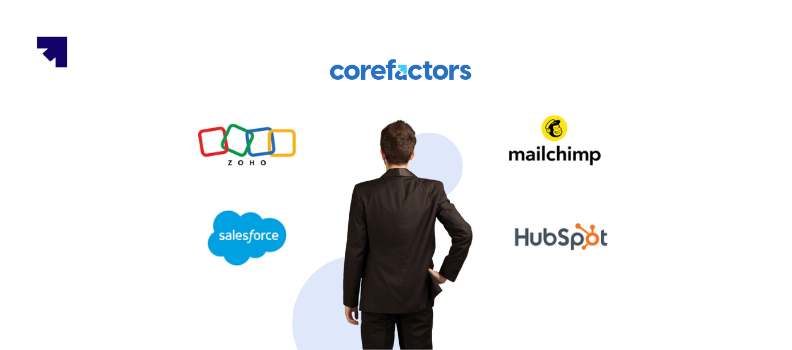
N Suresh
Join us on November 6th as Mr. Yash Mishra, Product Manager, Fatakpay, reveals the precise strategies that eliminates the speed trap and guarantees a 30% conversion boost.
Choosing the right marketing CRM isn't about finding one with the most features. It’s about choosing the one that fits the way you market, integrates with your tools, adapts with your team, and actually empowers execution. For every dollar invested in the right CRM software, businesses can expect an average return of $8.71.
This blog unpacks the non-negotiable features that define a high-performing marketing CRM, so you can stop second-guessing your tech and start building smarter, faster, and with clarity.
Whether you're a marketing strategist, growth lead, or digital marketer tired of duct-taped systems and stagnant dashboards, this guide is your blueprint for making a CRM decision that fuels real, measurable growth.
Why Choosing a Marketing CRM Is a Strategic Decision
Choosing a marketing CRM for your business will be a key foundational decision, rather than just a software choice, as the CRM has the power to influence how your organization understands, engages, and converts demand. This choice determines whether your marketing function operates reactively or evolves into a data-informed growth engine.
A robust marketing CRM should serve as the operational intelligence layer, connecting behavioral signals, orchestrating automation, and informing real-time decisions. For marketing leaders focused on pipeline velocity, cost efficiency, and campaign return on investment (ROI), the CRM acts as the infrastructure that governs how demand is built, nurtured, and converted.
Key Considerations while choosing a marketing CRM
- Lead Management: Can it effectively capture, score, and guide leads through the buyer journey? A strong CRM must support lead nurturing with marketing automation to keep prospects engaged and push them toward conversion.
- Audience Segmentation: Does it intelligently segment your audience based on behavior, demographics, and engagement data?
- Campaign Automation: Does it support marketing automation at scale to deliver timely, relevant messaging across channels, without manual effort slowing you down?

The Strategic Delta Between Sales CRMs and Marketing CRMs
Most organizations are familiar with sales-centric CRMs, the systems built around contact management, deal stages, pipeline, and sales forecasting. While these platforms support downstream activity, they often lack the upstream intelligence marketing teams require to drive performance.
In contrast, a marketing CRM is engineered for audience intelligence, multichannel marketing orchestration, and campaign agility. It consolidates fragmented data from email, SMS, social, web, and ad platforms to enable contextual, timely communication at scale.
Comparison Between Sales and Marketing CRMs
- Focus: Sales CRMs concentrate on closing deals, whereas marketing CRMs focus on generating and automating lead nurturing.
- Functionality: Marketing CRMs offer advanced segmentation, behavioral tracking, and campaign automation.
- Integration: Both sales and marketing CRMs integrate seamlessly with various platforms to provide a unified view of customer interactions.
Some modern CRMs, like Corefactors, merge the upstream precision of a marketing CRM with the downstream discipline of a sales CRM, removing silos between teams and creating a shared operating system for revenue.
Instead of pushing leads across systems and hoping they stick, Corefactors ensures every signal is captured, every action is timely, and every opportunity is measurable. This comprehensive approach supports inbound vs outbound marketing strategies by effectively managing leads generated through both attraction-driven inbound methods and proactive outbound outreach.
They offer:
- Integration with email, SMS, social, and ad platforms
- Advanced segmentation and behavioral tracking
- Real-time campaign performance dashboards
- Intent-driven lead prioritization and routing to sales
- Native automation across the entire customer journey
- Single-view customer profiles with marketing and sales history
Key Features of Marketing CRM
Overlooking the core capabilities of a marketing CRM is like scaling operations without aligning your tech stack. It may work for a while, but it won't scale efficiently or sustainably.
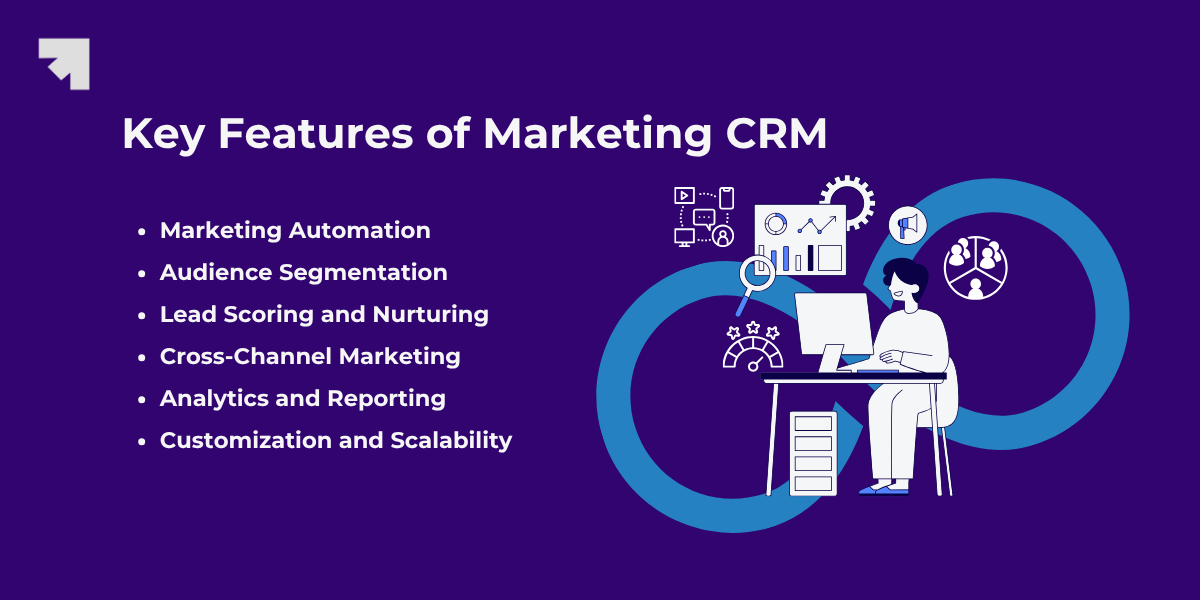
1. Marketing Automation
Manual workflows might work for a five-email campaign, but they collapse when you’re managing multi-segment product launches, re-engagement strategies, or retention journeys at once.
Marketing automation ensures consistency, accountability, and momentum at scale while saving your time significantly. A high-functioning CRM should allow your team to:
- Automate onboarding sequences based on user behavior
- Trigger follow-ups based on content engagement
- Shift prospects between journeys depending on the lifecycle stage
According to Nucleus Research, companies using marketing automation report a 14.5% increase in sales productivity and a 12.2% reduction in marketing overhead. These gains stem from eliminating repetitive tasks and focusing on high-impact strategy.
Look for CRMs with intuitive workflow builders, conditional logic, and deep integrations with your content, ads, and product stack. Execution speed becomes a competitive advantage when systems run intelligently.
This is where the benefits of marketing automation become evident:
- Higher conversion rates
- Faster pipeline velocity
- More efficient campaign execution
- Real-time behavioral triggers
- Improved conversion tracking
2. Audience Segmentation
Generic campaigns are ROI killers. A powerful CRM allows for audience segmentation beyond mere demographic fields to real-time behavior, intent signals, lifecycle stage, and psychographic profiles. Segmentation can boost conversion rates by up to 50%.
Segmentation ensures your message reaches the right person, at the right time, with precisely the right content. By harnessing behavioral data within your CRM, you can route leads into highly personalized nurture paths, increasing both relevance and revenue.
3. Lead Scoring and Nurturing
Not every lead is sales-ready. That’s where lead scoring comes in, allowing you to assign value based on
- Behavioral engagement (e.g., webinar attendance, case study views)
- Content interactions
- Demographic fit
High-score leads can be instantly routed to sales teams, while colder leads enter automated nurturing sequences that gradually build intent. Without these capabilities, you risk wasting sales bandwidth and underdeveloping valuable prospects.
4. Cross-Channel Marketing
The modern customer journey is non-linear. One day, it's an email. Next, it's LinkedIn, SMS, or a retargeting ad.
Your CRM must empower orchestrated communication across multiple touchpoints, without losing coherence. With cross-channel marketing, you can deploy synchronized campaigns across SMS, email, push notifications, ads, RCS chats, and more, from a single interface.
This unified orchestration improves customer experience and accelerates conversions seamlessly.
5. Analytics and Reporting
The most powerful CRMs reveal what’s working, what’s not, and what to do next.
Look for analytics capabilities that offer:
- Funnel velocity insights to help identify and prioritize stalled leads before they go cold.
- Multi-touch attribution to uncover which touchpoints truly drive conversions, so you can focus your efforts where it matters most.
- Channel influence analysis to guide budget shifts toward the platforms delivering proven ROI.
- Cohort behavior tracking to personalize customer journeys for your highest-converting segments.
- Adaptive dashboards that surface next-best actions, empowering your sales and marketing teams to act with precision.
Organizations leveraging advanced marketing analytics are 23X more likely to acquire customers and 9X more likely to retain them.
So, look for platforms with customizable dashboards, cohort analysis, multi-touch attribution, and real-time visualizations to pull your growth lever.
6. Customization and Scalability
Marketing teams evolve. So do funnels, workflows, and reporting needs. Your CRM should not require a rebuild every time your strategy shifts. What works for a 10-person team won’t work for a 100-person operation or at an enterprise level.
Your CRM should handle:
- Modular architecture and workflow customization
- Flexible API integrations with other marketing and sales tools
- Role-based dashboards and permissions
- Support for multi-product, multi-segment structures
Whether you're a startup or scaling enterprise, if your CRM can't grow with your ambitions, without replatforming every 12 months, it will ultimately work against them.
Top 5 Marketing CRM: A Comparison
Let’s be honest, marketing automation is on every CRM’s homepage, but when you peel back the layers, the capabilities vary dramatically. Before you commit your team and your budget, it’s crucial to dig deeper.
1. Corefactors
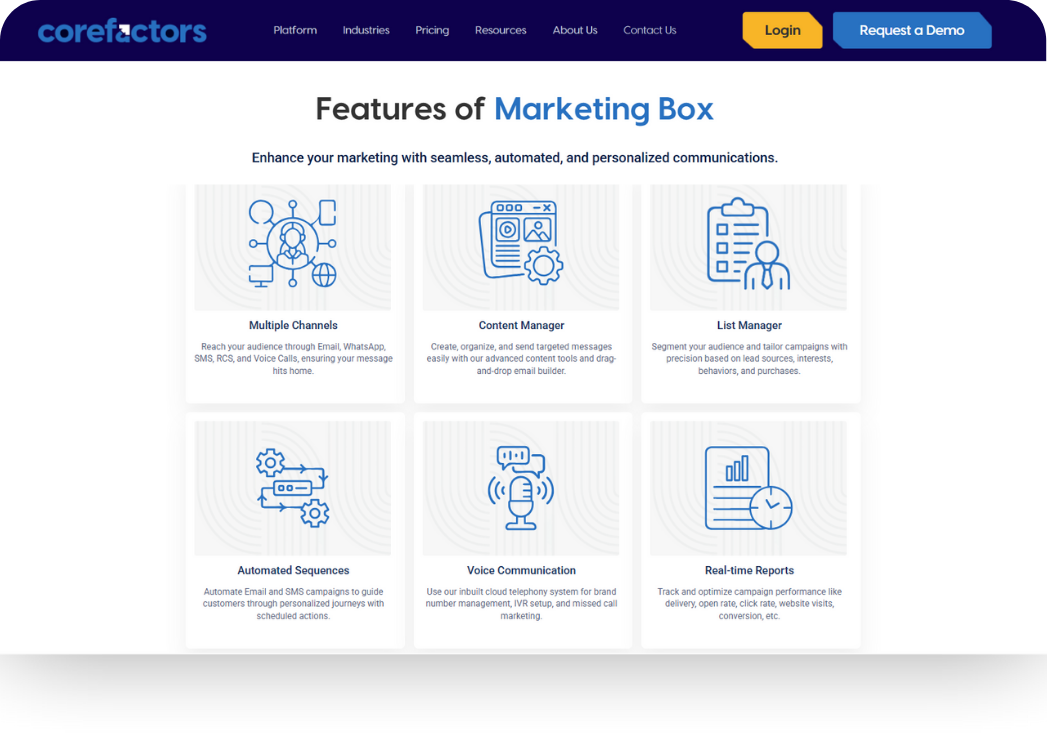
Corefactors positions itself as an all‑in‑one RevOps platform, seamlessly integrating sales, marketing, support, and success. It’s competitively priced, especially for emerging and mid‑market teams, offering built-in telephony, omnichannel outreach, and AI-driven lead intelligence, without the need for external tools.
- Marketing Automation: Robust across tiers. Journey builder with email, SMS, and WhatsApp campaigns, drip automations, content templates, and landing page editor for mid‑tiers. Advanced tier adds custom API workflows and multiple journeys.
- Segmentation: Real-time filters based on lead fields such as industry size, source, geography, and engagement.
- Lead Scoring: Manual and rule-based scoring from basic tiers. Smart field mapping unlocks at advanced tiers.
- Multi Channel Marketing: Native support for email, SMS, calls, and WhatsApp. Mid tiers include cloud telephony, auto lead distribution and reply, call logs, recordings, and multi-channel workflows.
- Built-In Support and Success Tools: Ticketing, SLAs, renewal reminders, and customer history are built into the CRM.
- Reporting and Dashboards: Custom dashboards covering target management, agent and team productivity, attendance management, calls, funnels, campaigns, support, and renewals based on tiers.
- Premium Support and Onboarding: All plans include onboarding and training. Enterprise-level advanced tier includes enhanced support SLAs, AI call intelligence and insights, Meta Ads CPL integration, AI email writer and required customizations.
Best For: Small to mid-market teams seeking an affordable, full-featured CRM with built-in multichannel communication and automation ideal for telesales, education, healthcare, BFSI, manufacturing, automobile, and service-led industries.
2. Mailchimp
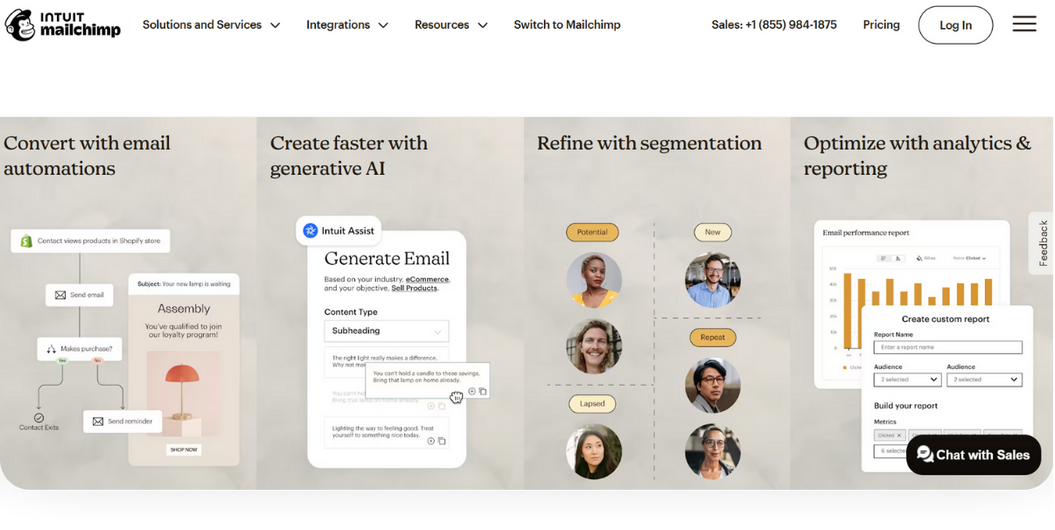
Mailchimp is a solid choice for early-stage businesses dipping their toes into email marketing. It’s intuitive, comes with essential features, and helps you set up quickly. But when your strategy matures like real-time automation, multichannel orchestration, or lead scoring, it begins to show its limits.
- Marketing Automation: Basic workflows and email sequences.
- Segmentation: Allows behavioral targeting and custom audience creation. Can segment based on purchase activity, campaign engagement, and website behavior.
- Cross-Channel Marketing: Supports email, landing pages, and basic social posting but they operate in silos, and all threeare available in the premium plan.
- Reporting: Offers campaign performance dashboards and A/B test results, but limited cohort or lifecycle tracking.
Best For: Solopreneurs or small teams launching email campaigns who don’t yet need complex journeys, scoring models, or multichannel orchestration.
3. Salesforce
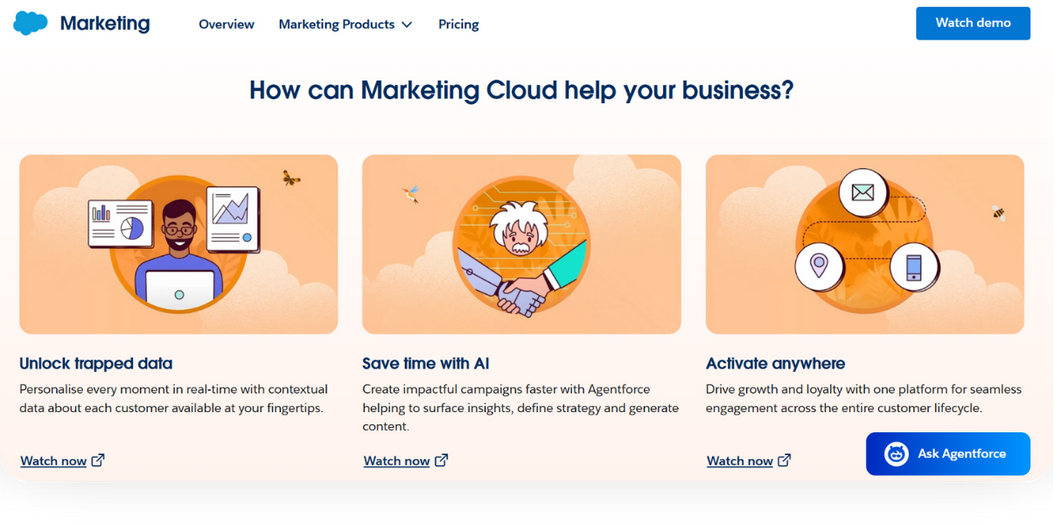
Salesforce Marketing Cloud is powerful, but it comes with a steep learning curve and even steeper costs. Implementation requires technical teams, and ongoing optimization often demands outside consultants.
- Multi‑Channel Journeys and Forms: Blend email, SMS, landing pages, and forms into unified, automated customer journeys.
- AI Scoring and Path Experimentation: Leverage built-in AI scoring and path experimentation to optimize engagement.
- Unified SMS Conversations: Integrate SMS and WhatsApp messaging directly into your customer interaction workflows.
- Predictive Personalization Tools: Access advanced personalization with segmentation and content delivery.
- Cloud Add‑Ons (e.g., Data Cloud, Intelligence, Personalization): Add structured data storage, analytics, and personalization at enterprise scale.
- Success and Support Plans: Choose support levels ranging from self-service to 24/7 access and dedicated success managers depending on the pricing plan.
Best For: Large enterprises managing massive data, audiences, and touch points.
4. HubSpot
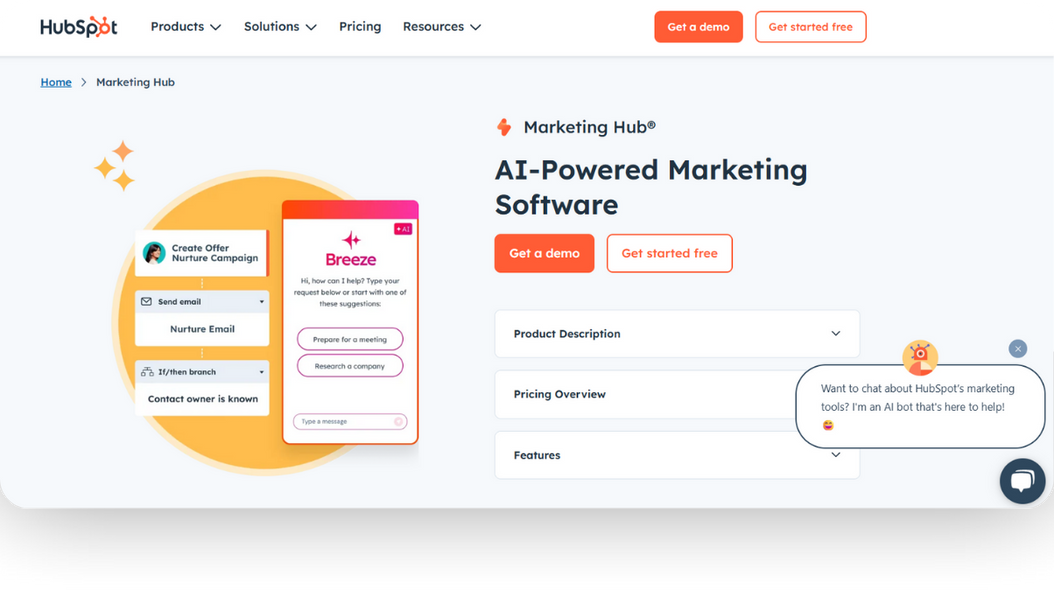
HubSpot offers an enterprise-grade stack that’s intuitive enough for mid-sized teams scaling their marketing efforts. It’s user-friendly, well-documented, and integrates seamlessly across marketing, sales, and support. However, many powerful features are gated behind higher pricing tiers, making scalability potentially expensive.
- Marketing Automation: marketing workflows with advanced branching logic and event-based triggers.
- Adaptive Testing: Provides A/B testing in all plans..
- Lead Scoring: Limited lead scoring available from the Professional tier. Enterprise tier provides behavioral event-based and predictive lead scoring
- Omni Channel Marketing: Automate campaigns across email, web, ads, and social media with omnichannel workflows tailored to pricing tiers.
- Premium Support and Onboarding: Dedicated onboarding, 24/7 enterprise support, compliance features, and security controls.
- Reporting: Customizable reports on campaign health, market asset comparison, and social and media campaigns.
Best For: Large organizations seeking advanced attribution modeling, funnel insights, multi-channel governance, and unified campaign orchestration across departments.
5. Zoho CRM

Zoho CRM is one of the most budget-friendly platforms on the market, with strong customization and native sales features. However, its marketing automation feels like a bolt-on rather than a native capability, requiring integration with Zoho Marketing Automation or Zoho Campaigns for a complete experience. Ideal for tech-savvy teams who don’t mind piecing tools together.
- Marketing Automation: Basic to moderate. Native workflows and web forms included; full journey-building and multichannel orchestration require integration with Zoho Marketing Automation (ZMA)
- Segmentation and Lead Scoring: Uses lead scoring and tags to segment the audience.
- Cross-Channel Marketing: Limited in the core CRM. Email and chat are supported natively. SMS, social media, and WhatsApp require extensions or add-ons like ZMA.
- Premium Support and Onboarding: 24/5 standard support, 24/7 available in higher tiers. Onboarding may need third-party help or in-house effort.
- Reporting: Customizable dashboards and reports by default. Zia AI (Enterprise) offers forecasting and deal insights. Ultimate tier unlocks advanced analytics via Zoho Analytics.
Best For: Price-sensitive teams with strong internal tech capabilities who need a customizable CRM and are willing to configure or integrate tools for full-scale marketing automation and analytics.
So, Why Corefactors?
Because your CRM should match your growth mindset, while others make you choose between usability and power, Corefactors marketing CRM delivers both. It’s agile, deeply integrated, and backed by proactive support that actually understands your journey beyond your tickets.
Corefactors can check every box:
- Real-time marketing automation
- Segmentation and lead prioritization
- Multi-channel orchestration via email, SMS, WhatsApp, voice, and RCS chats
- Single-view customer intelligence from marketing to sales
- Intent-based routing and follow-ups
- Customizable analytics dashboards
If you're scaling fast and need a marketing CRM that can keep pace without the bloat or budget burn, Corefactors can be your safe bet.
Tracking Marketing KPIs with a CRM
Once you've gone through the process of choosing a marketing CRM, the next step is tracking its performance. To truly maximize your marketing ROI, your CRM must provide transparent, real-time visibility into marketing KPIs to track and enable actionable insights.
These kwy performance indicators (KPIs) reveal the effectiveness of your campaigns and the health of your customer journey. They are the navigational instruments that guide strategic marketing decisions, resource allocation, and campaign optimization.
Your CRM should allow you to monitor:
- Lead Conversion Rate: The percentage of prospects who become customers. It reveals how well your marketing nurtures interest into actual sales.
- Campaign Engagement: Measures how actively your audience interacts with your emails, ads, and messages, like clicks, opens, and shares, which show if your content hits the mark.
- Customer Lifetime Value (CLV): The total revenue a customer generates over their entire relationship with your business. Higher CLV means your marketing isn’t just winning customers but loyal ones.
- Funnel Drop-offs: These are the points where potential customers abandon the journey. Spotting these leaks helps you fix friction and keep prospects moving forward.
- Cost per Lead (CPL): How much do you spend on average to get a new lead? Keeping this low while maintaining quality is marketing efficiency in action.
- Conversion Rate per Campaign: The success rate of individual marketing campaigns in turning leads into customers helps you focus on what truly works.
- Email/SMS Open and Click-Through Rates: The percentage of recipients opening your messages and clicking links shows how compelling your outreach really is.
- Customer Acquisition Cost (CAC): The total cost of winning a new customer, including marketing and sales expenses. Balancing CAC with CLV is key to profitable growth.
Make Your CRM Your Growth Engine
Choosing marketing CRM isn’t just about ticking boxes; it’s a strategic move that transforms how your team connects, engages, and grows revenue.
When equipped with the right features from seamless automation to real-time KPI tracking, it becomes the engine that drives smarter decisions, faster execution, and campaigns that truly convert. Because choosing your CRM isn't merely a software choice for your business, but your first decision towards revenue strategy.
Corefactors is designed for marketers who demand clarity, control, and measurable impact with no compromises.

Heading 1
Heading 2
Heading 3
Heading 4
Heading 5
Heading 6
Lorem ipsum dolor sit amet, consectetur adipiscing elit, sed do eiusmod tempor incididunt ut labore et dolore magna aliqua. Ut enim ad minim veniam, quis nostrud exercitation ullamco laboris nisi ut aliquip ex ea commodo consequat. Duis aute irure dolor in reprehenderit in voluptate velit esse cillum dolore eu fugiat nulla pariatur.
Block quote
Ordered list
- Item 1
- Item 2
- Item 3
Unordered list
- Item A
- Item B
- Item C
Bold text
Emphasis
Superscript
Subscript
Frequently Asked Questions (FAQs)
What should I look for when choosing a Marketing CRM?


Focus on features like contact management, integration capabilities, analytics, and ease of use to ensure it meets your marketing needs.
How does a marketing automation platform complement a Marketing CRM?


It automates campaign workflows and lead nurturing, enhancing the CRM’s ability to manage customer relationships effectively.
Are integration options important in a Marketing CRM?


Yes, seamless integration with other tools, especially marketing automation platforms, ensures efficient data sharing and campaign execution.
Can small businesses benefit from a Marketing CRM with automation?


Definitely, combining CRM with marketing automation helps small businesses streamline marketing efforts and grow without extra resources.





















.png)




.png)